English CBSE Class 12 NCERT Flamingo Poem 2 An Elementary School Classroom in a Slum Free Solution of Extra Questions and Answers – Extract Based Questions Short Answer Questions Long Answer Questions and Value Based Questions
AN ELEMENTARY SCHOOL CLASSROOM IN A SLUM
(Extra Questions)
Multiple Choice Questions
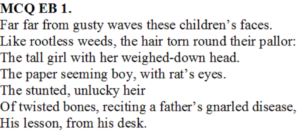

(i) Which of the following is not implied by ‘The paper seeming boy, with rat’s eyes’?
(a) Paper is sharp after studying in a school
(b) Killed a rat with a paper
(c) Lean and thin because of hunger
(d) Confused between a paper and a rat
(ii) Based on the extract, please select the correct option –
Assertion: The tall girl with her weighed-down head.
Reason 1 – She bears the burden of poverty
Reason 2 – She is worried about difficulties of her life
(a) Reason 1 is a valid reason for the assertion
(b) Reason 2 is a valid reason for the assertion
(c) Neither Reason 1 not Reason 2 is a valid reason for the assertion
(d) Both Reason 1 and Reason 2 are valid reasons for the assertion
(iii) Which of the following word does not represent ‘gusty waves’ as implied in the extract?
1. Happiness
2. Struggle
3. Brightness
4. Enthusiasm
5. Apathy
(a) 1 and 4
(b) 2 and 3
(c) 2 and 5
(d) 4 and 5
(iv) Which poetic device is used in ‘paper seeming boy’?
(a) synecdoche
(b) simile
(c) metaphor
(d) alliteration
(v) According to the extract, who is suffering from disease?
(a) father
(b) girl
(c) boy
(d) both (a) and (c)
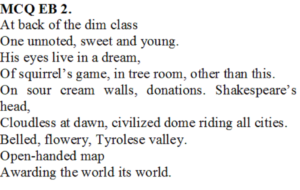

(i) The reference to ‘Tyrolese valley’ has been made to indicate that the world is full of
(a) pleasure
(b) problem
(c) penance
(d) possibility
(ii) Which of the following has not been attributed to the boy sitting at the back of the class?
1. not noticed
2. sad
3. playful
4. young
5. sweat
(a) 1 and 2
(b) 3 and 4
(c) 1 and 4
(d) 2 and 5
(iii) Which of the following correctly represents the theme of the extract?
(a) Every child is full of sadness
(b) Children usually get distracted by the world
(c) World is full of opportunity – one needs to dream
(d) It is futile to dream when child is poor
(iv) As per the extract, what does ‘civilised dome’ represent?
(a) Shakespeare’s head
(b) The sour cream walls
(c) The Sun
(d) Tyrolese valley
(iv) Which poetic device has been used in ‘Awarding the world its world’?
(a) simile
(b) metaphor
(c) repetition
(d) irony
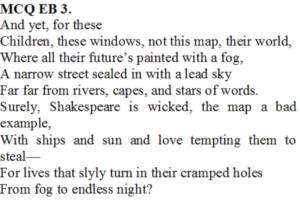

(i) Which of the following has not been used to indicate an obstruction?
(a) painted with a fog
(b) sealed in with a lead sky
(c) their cramped hole
(d) not this map, their world
(ii) Which of the following line has a different poetic device?
(a) Narrow street
(b) Sealed in with lead a sky
(c) Stars of wisdom
(d) Far far from rivers
(iii) Which of the following has not been used in the extract as a symbol of opportunity?
(a) river
(b) cape
(c) ship
(d) night
(iv) The symbols of opportunity drive children towards –
(a) sun
(b) ship
(c) stealing
(d) street
(v) According to the passage, the children are –
(a) optimistic
(b) practical
(c) rational
(d) resigned
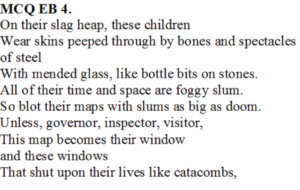

(i) Titles of some books are given in following options. Which of these relates with ‘catacomb’?
(a) Atomic Habits
(b) The Labyrinth
(c) Freedom at Midnight
(d) The Hopeful Life
(ii) Based on the following statements please choose the correct option.
Statement 1: Poet is sympathetic towards children living in slum
Statement 2: Poet has exaggerated plight of children to gain popularity
(a) Both statements are true
(b) Statement 1 is true but Statement 2 is false
(c) Both statements are false
(d) None of the statements can be inferred
(iii) Which of the following has not been used to indicate poverty of children living in slum?
1. spectacles
2. slag
3. window
4. foggy
5. visitor
6. doom
(a) 1 and 4
(b) 2 and 3
(c) 3 and 5
(d) 2 and 4
(iv) Which word as used in the extract is closest to ‘redone’?
(a) slag
(b) mended
(c) blot
(d) doom
(v) Which of the following option has incorrect combination?
(a) like bottle bits on stones – simile
(b) slums as big as doom – metaphor
(c) space are foggy slum – pun
(d) All of their time – alliteration
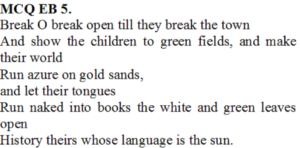

(i) Which of the following has been used to represent ‘hopelessness’?
(a) green fields
(b) run azure
(c) history theirs whose language is the sun
(d) None of the above
(ii) The theme of the extract is –
(a) shrewd
(b) hope
(c) surrender
(d) anger
(iii) According to the extract who can write a history?
(a) Those who have the courage to break away from present
(b) Those who have the desire to traverse untrodden path
(c) Those who believe in light and growth
(d) All the above
(iv) Which of the following word as used in the extract does not represent a colour?
1. green
2. azure
3. gold
4. white
5. sun
(a) only 1
(b) only 3
(c) only 2
(d) only 5
Extract Based Questions
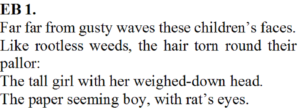

1. Identify the poem and the poet.
2. Which children the poet is talking about?
3. Why has the tall girl put her head down?
4. Name the poetic device used in the second lines of the extract.
5. Name the poetic device used in the first line of the extract.
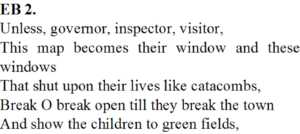

1. Identify the poem and the poet.
2.What does ‘break O break open’ mean?
3. What is the meaning of ‘green fields’?
4. Name the poetic device used in the fourth lines of the extract.
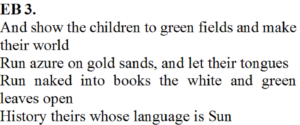

1. Explain ‘run azure on gold sands’.
2. According to poet who can create history?
3. What does ‘let their tongue naked into book’ symobolise?
4. What is the poetic device used in ‘let their tongue naked into book’?


1. Why is the class room dim?
2. How is the young child different from others?
3. What is a tree room?
4. What is the poetic device used in ‘in tree room, other than this’?


1. What is meant by ‘slag heap’?
2. What is the poetic device used in third line of the extract.
3. What is meant by ‘skins peeped through by bones’.
4. Which word in the extract is synonym of ‘repaired’?


1. What do the ‘windows’ and ‘maps’ symbolize?
2. What is the poetic device used in second line of the extract?
3. What does future hold for these children?
4. How is these children’s world different from the one on the map?
Short Answer Questions – 30 to 40 words


Answer: They dream of open spaces, green environment, happiness and opportunities. A boy sitting in the class looks out of the window and observes a squirrel playing. This signifies their aspiration to live in an open world and a life full of play and happiness.


Answer: Poet describes their conditions as living in a narrow street sealed with a lead sky, far away from rivers, capes and stars of word. This signifies absence of open space, opportunity and education. They live in filthy condition and they are very poor.


Answer: The poet describes the poor conditions of children living in slums. He describes the social injustice and inequality prevailing in the society.
Poet suggests that government and public should do all required to provide opportunity to these children. We should give them education, clean environment and open spaces to play.


Answer: These powerful people can frame new laws to provide education to these children. They can initiate drive to ensure cleanliness. Better employment opportunity can be provided.
Thus the barrier for their development can be removed. Then people living in slum will lead a better socio-economic life.


Answer: ‘Gusty waves’ symbolizes ‘full of energy’.
These children are confined to their slums. They do not have access to education, clean environment and opportunity for growth. Their life is dull, poor and full of restrictions.
Thus their life is far from ‘gusty waves’.
Long Answer Questions – 120-150 words


Answer: In this line ‘the Sun” means growth. When Sun rises all the darkness in the world is removed. The whole world is filled up with light. This signifies enlightenment and growth. Poet means to say that those who strive for growth, make efforts to outshine their difficulties can create history.
Some people accept difficulties of life as their destiny. Such people do not grow. They would always be cursing the circumstances.
On the other hand, there is group of people who takes up the task of overcoming difficulties. Dhirubhai Ambani was an attendant at a fuel filling station. Still he created one of the best business organisation in the country. Rajnikant was a bus conductor. Milkha Singh was extremely poor. Bill Gates started his organisation in a garage. The history is full of such example.
Hence those who work hard to overcome difficulties always create history.


Answer: The atmosphere in the class room is full of despair. Students seems to have accepted their condition. They do not hope for any change in their living conditions. The atmosphere outside is full of cheer. Energy and vigour.
The condition inside the classroom represents stunted growth and limited or no opportunity for growth. The outside world represent immense possibilities and infinite opportunities for growth.
Most students in the classroom, though shown a glimpse of outside world through posters and pictures, do not have the courage to break the shackles of their socio-economic condition. They seem to have accepted that nothing can change for them. But they have understood that the world outside their boundary is totally different for their present space.


Answer: My first priority would be to ensure cleanliness and hygiene in the area. The filthy conditions is detrimental to health. Little do we realise that we spend a lot when we fall sick. Thus cleanliness would help them avoid avoidable expenses.
My second priority would be making arrangements for education to each and every child. I would take help of various NGOs. In addition to formal education, I would like to include skill development programmes like welding, carpentry, electrician and plumbing. Such programmes could ensure economic well-being of society. I would arrange scholarship for those children who decide to purse higher education
I would concentrate my efforts on women empowerment. I would design specific courses like tailoring, knitting and cooking. I would make self-help groups. I shall invite various commercial outlets to appreciate their skills. I would encourage these organisations to source their requirement through self-help group.
I am of the opinion that above initiatives would improve their living standards.
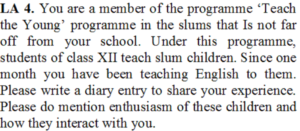

25th Feb 20XX
Saturday
09:00 PM
Dear Diary,
A month ago, when I enrolled for ‘Teach Them Young’ programme, little did I know that it would be such a satisfying experience. I am teaching English to kids of the age group 10 to 12.
During first week I talked about tenses. The language of teaching was a mix of English and the local language. I used charts to explain the concepts.
Next week I took up verbs. Within three days, they were able to recall three forms of many verbs.
Next week I took up the concept of articles. It was a bit difficult to understand so I focused more on giving solved examples. Bingo! It worked well. Kids were bubbling with confidence. Each question of every exercise was answered with an accuracy of an arrow hitting bull’s eye.
Signature
****

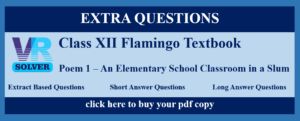

0 Comments